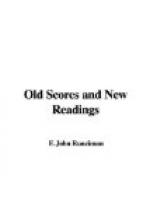After hearing the whole opera twice, with all the supposed advantages of the stage, the main thing borne in upon me is that the stage and actors and accessories, far from increasing the effect of the music, actually weaken it excepting in the first act. In that act there is not a word or a note to alter. The story compels one’s interest, and the music is rich, tender, and charged with a noble passion. Even the killing of the duck—it is supposed to be a swan, but it is really a duck—is saved from becoming ludicrous by the deep sincerity of the music of Gurnemanz’s expostulations. The music, too, with the magnificent trombone and trumpet calls and deep clangour of cathedral bells, prevents one thinking too much of the absurdity of the trees, mountains, and lake walking off the stage to make the change to the second scene. On reflection, this panorama seems wholly meaningless and thoroughly vulgar; and even in the theatre one wonders vaguely what it is all about—for Gurnemanz’s explanation about time and space being one is sheer metaphysical shoddy, a mere humbugging of an essentially uncultured German audience; but one does not mind it, so full is the accompaniment of mystical life and of colour, of a sense of impending great things. The whole cathedral scene—I would even include the caterwaulings of Amfortas—is sincere, impressive, and filled with a reasonable degree of mysticism. There is no falling off in the second act until after the enchanting waltz and Kundry’s wondrously tender recital of the woes suffered by Parsifal’s mother (here the melody compares in loveliness with the corresponding portion of “Siegfried"); indeed, the passion and energy go on increasing until Parsifal receives Kundry’s kiss, and then at once they disappear. Between this point and the end of the act there is scarcely a fine passage. Every phrase is insincere, not because Wagner wished to be insincere, but because




